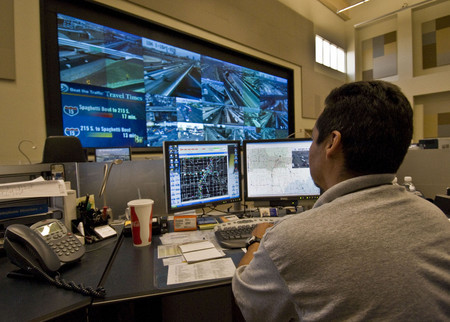With stoplights, timing isn’t everything

Brian Hoeft is the leader of the red light district in Las Vegas. OK, not really, but he does have control of when traffic signals turn red, or green, in his role as assistant director of the Regional Transportation Commission’s Freeway & Arterial System of Transportation (FAST).
And because of that job, Hoeft knows a lot about how signals work and why your commute is smooth, or why it might not be. That is because FAST communicates with fiber cables that monitor traffic flow. So, if it seems you hit every red light on the way to work, don’t lash out at Hoeft. The guy really does care, and he’s willing to personally check out your concerns.
Here’s an example:
Earlier this month, C. Stockwell asked: Why can’t they synchronize the lights better from Decatur to I-15 on Blue Diamond? It is a frustrating stop and go every day and at any time of the day, especially when no one is coming out of Arville or the Target shopping area.
I relayed this concern to Hoeft, and initially his response was that he drives that route fairly routinely and hadn’t noticed any synchronization problems. But he didn’t stop there. Because that stretch isn’t equipped with fiber cables, FAST can’t communicate with the light controls remotely, so Hoeft went and examined the system himself.
What he found was that the traffic signal clock had drifted so that the lights were not timed correctly. The problem should be fixed now. Motorists who use that road have Mr. or Mrs. Stockwell to thank for that.
Susan also had a question fitting for Hoeft: Why are traffic signals so often timed so that when a big bulk of traffic arrives at the intersection, the light turns red. It really encourages speeding.
If you are on a major arterial, Susan, this should not happen frequently. Signals are timed during the morning commute to favor eastbound traffic with hopes of getting as many cars through a light as possible. In the evening, you’ll find that westbound traffic is smoother.
There are a few exceptions. For example, if you’re happily cruising through every green light traveling east on Charleston in the morning, you might hit a snag at a competing commuter arterial, such as Rainbow Boulevard. If more traffic uses Rainbow south, those lights might be a priority over Charleston.
Other events can throw off the lights. Construction zones or emergency vehicles can affect the timing, but it takes only a few minutes to get back into the flow. One more note, Susan, if there is a specific intersection to which you are referring, let me know and Hoeft will go check it out.
Carol’s beef is Durango Drive between Cheyenne Avenue and Centennial Parkway: Even if you go the speed limit, every light is red. It is a major road but treated as a secondary road.
FAST has reviewed this section before, Carol, and the folks there are willing to do it again. But the last time they checked out Durango, traffic as it approached Centennial seemed to thin out.
Even though some roads appear to be dinky side streets, they might be more heavily traveled than Durango and therefore are a priority as far as traffic flow.
Last week’s item related to handicap parking laws appeared to cause more confusion than clarity, so I’d like to apologize and clarify the rules:
In the unincorporated county, where Las Vegas police enforce the rules, handicap vehicles can’t park in metered spaces without paying.
In the city, which handles its own enforcement, handicap vehicles can park for free in metered, on-street spaces but not in parking garages, according to city spokeswoman Diana Paul.
As I mentioned last week, any vehicle with the disabled placard may park in spaces marked van accessible.
But this is not to be confused with signs that say the space is reserved for side-loading vehicles. Those spaces are for side-loading vehicles only, and the fine for violating that infraction is $250.
If you have a question, tip or tirade, call Adrienne Packer at (702) 387-2904, or send an e-mail to roadwarrior@reviewjournal. com. Include your phone number.
Continuing through Thursday, traffic lane restrictions will be in effect at the Decatur Boulevard and Alta Drive intersection during overnight hours, 9 p.m. to 6 a.m.Decatur will narrow to two lanes in each direction. Although lane restrictions will not apply to Alta, motorists are urged to be cautious as they maneuver through the intersection. The restrictions are scheduled to be lifted by 6 a.m. Friday.
The road work is a result of city of Las Vegas crews modifying the traffic signal as part of an effort to bring the intersection up to current Americans with Disabilities Act standards.
Overnight work also will continue on Flamingo Road at Las Vegas Boulevard through Friday morning. Expect lane reductions on both roadways between 9 p.m. and 6 a.m.
Traffic on Las Vegas Boulevard will be reduced to two lanes in both directions beginning about 1,000 feet from the Flamingo intersection. Eastbound lanes on Flamingo between Audrie and Koval lanes also will be reduced during the overnight hours.
Because of work on the Tenaya Way overpass at Summerlin Parkway, the U.S. 95 southbound ramp to Summerlin Parkway west will be closed until the end of September.
A note for commuters between California and Nevada: The rock-blasting work between Nipton and Bailey roads is complete, and there will be no more lane closures related to that project. It’s no longer necessary to avoid Tuesday and Thursday mornings along that stretch.












